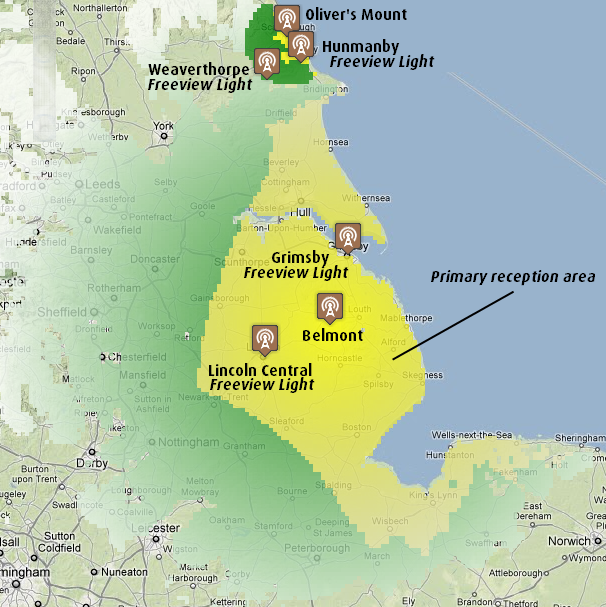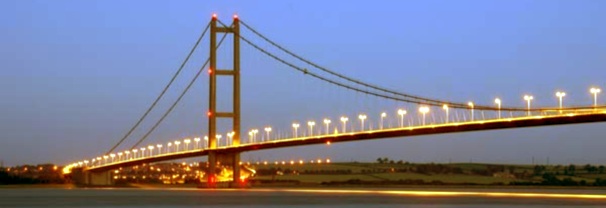Switchover starts in East Yorkshire and Lincolnshire
 Brian Butterworth published on UK Free TV
Brian Butterworth published on UK Free TV This week sees the first stage of the digital television switchover for 747,300 homes in East Yorkshire and Lincolnshire.
From 6am Wednesday 3rd August 2011, you must to a perform a "first time installation" retune (sometimes "Factory Reset" or "Shipping Condition") on your Freeview box or television set if you use the Belmont or Oliver's Mount full service Freeview transmitters. This is because the old "multiplex 1" BBC service will be replaced by the BBCA multiplex on a different frequency.
If you use the Grimsby (by noon), Hunmanby (9am), Lincoln Central (by 9am) or Weaverthorpe (by 6am) relay transmitters, from Wednesday 3rd August 2011 you will be able to receive the BBC Freeview services (with the exception of HD) for the first time, and you will no longer be able to view BBC TWO on analogue.

You MAY find that old equipment will no longer work - see TVs and boxes that do not support the 8k-mode

On Wednesday 17th August 2011 will see the second stage of switchover, which provides the final Freeview configuration, including Freeview HD for all transmitters in this region.
On this date, you will need, once again, to do a "first time installation" as indicated above.
A small aside
Whenever I hear the name "Belmont", it reminds me of seeing this card on the ITV button in the morning
Which was accompanied by this music and voice: Yorkshire Television Theme Tune which I guess must have been some early inspiration for this site...
5:38 PM
Sheffield
Actually to this point David - Have you tried attenuating the signal your receiving?
| link to this comment |
KB's: mapK's Freeview map terrainK's terrain plot wavesK's frequency data K's Freeview Detailed Coverage
5:59 PM
Steve P: It is only standard that BBC Two is the first channel switched off. This is because it has the lowest viewing figures of the four channels carried on every transmitter (or had when the plans were made, it has now passed Channel 4) and because it often had the best frequency allocation, as the first channel to start up on UHF, so high-power BBC A usually takes that over.
The move of a different analogue channel to BBC Two's old frequency will occur if the BBC A multiplex has been allocated the other channel's frequency. This might happen if BBC Two's frequency is one of those being released (31-38, 61-68, though sometimes 39 and 40 are freed and 61 and 62 retained temporarily). Or, if a relay has been allocated completely new channels. Sometimes, two of the four analogue frequencies are being released.
If an analogue swap occurs at DSO1 at a main transmitter, there may also be a channel swap at its relays, even if the clash with BBC A's frequency didn't occur, as then the relay equipment doesn't need to be retuned.
In the Sheffield/Chesterfield group next week, BBC A replaces BBC Two except at Hasland relay where it replaces BBC One, which replaces BBC Two for the switchover period.
For the Waltham group, in two weeks' time, BBC A replaces ITV1 at the main transmitter and all relays (except Derby, which doesn't transmit BBC Two at all).
At Emley Moor, on 7 September, ITV1 will move to BBC Two's frequency, as BBC A has been allocated ITV1's frequency.
At Belmont, Channel 4's frequency (C32) will be released, but BBC One, BBC Two and ITV1 frequencies are retained for the PSB services. It's not really clear why BBC A takes over BBC One's channel rather than BBC Two's, but that's what has been decided, so that leads to the situation here.
| link to this comment |
6:24 PM
KB Aerials Sheffield: Suggesting a multi-channel filter for a standard domestic installation is a little like using a sledgehammer to crack a nut! It'll do the job, but it's probably overkill and expensive.
It's worth noting that Emley Moor has never required a wideband aerial, it's always been Group B. Of course the grouping doesn't mean it picks up nothing at the lower channels, and often the polar response is more omnidirection out-of-group than within group.
In the centre of BD2, 24km from Emley Moor, I would think an attenuator will be *necessary* after switchover anyway (assuming 'high-gain' aerial and sat-grade cables in good condition). If that doesn't fix the overlap, using a diplexer as a filter should work to eliminate Group A frequencies. However, there is a possibility that the lower 'digital dividend' released area, C31-C38, will be used for future TV services - the diplexers I've seen have the split point at C36 or C38.
DUK's predictor reckons there's a good chance of getting Idle on C24/C21/C27/C42/C45/C39 - while this is on vertical polarization, it's not prepared to offer a prediction for Belmont, which David is already getting, and the cross-polarization rejection of the aerial is often similar to the front-back ratio. The predictor doesn't add off-beam rejection to cross-polar rejection, I assume you don't get any more rejection from being off-beam AND wrong polarization than from just one of those. If the box does pick Idle for the commercial muxes, even with a broadband filter, a narrow-band filter setup such as KB Aerials suggests is the only option.
It would be far cheaper to buy a new box that stores what it's told to, rather than mucking about with filtering, of course.
| link to this comment |
6:29 PM
Kieth,
The auto upate featured in the Set Up menu does not effect the please re-scan message on switch on.
I have tried the attenuation control of the aerial amp but only takes out the Idle reception. Belmont ch 22 is still stronger than Emley Moor.
Done all I'm going to do, await middle/end of September to see what possition is then.
Maybe the people in charge will adjust the beam direction of Belmont or the power, unless this is what they want from it.
| link to this comment |
8:35 PM
Sheffield
Mike suggests that your in a strong signal strength area (i don't know the area at all)
You've just suggested in your last post you have an amplifier on your system
If your in a strong signal strength area why have you got an amplifier on the system I realise sometimes if for instance your distributing sky then an amplifier is needed
is the aerial is fed into the amplifier then distributed to several points or just one
as Brian suggests - have you tried bypassing the amplifier
if mike is correct an attenuator is needed then to me if your not distributing sky then an amplifier POSSIBLY could be replaced with a splitter these are available in 2 3 4 6 8 outputs
the 2 way would lose 4 db
3 way 6 db
4 way 8 db
6 and 8 way splitter loses 13 db
so lets say your getting your signal at 60 db and have an amplifier of say 8 db then the signal at each tv is 68
if you swap the 8 db 4 way amp for a 4 way -8db splitter you drop down to 50 db - this may solve all problems
Obviously an analyser on the system and someone who knows what they are doing on site might not be a bad idea if you want to call someone out
Keith
| link to this comment |
KB's: mapK's Freeview map terrainK's terrain plot wavesK's frequency data K's Freeview Detailed Coverage
8:36 PM
Sheffield
sorry bad math - 52db at the set (god I need a calculator sometimes-- DOH)
| link to this comment |
KB's: mapK's Freeview map terrainK's terrain plot wavesK's frequency data K's Freeview Detailed Coverage
9:13 PM
Ormskirk
Hi too much signal is not as big a problem as you might think when wither hill switched i didnt have ine fail dut to over power and we are talking an area where i can get 78 dbuv off a lp45 log periodic i have also done a 8 way splitter off a xg10 with 60 dbuv per out put. If you are bothered about over signal and need to use a masthead amp over a splitter try the wolsey 4 way masthead with a 0 to 10 db gain these aer quiet good for medium signal areas.
| link to this comment |
Mazbar's: mapM's Freeview map terrainM's terrain plot wavesM's frequency data M's Freeview Detailed Coverage
12:33 PM
Lincoln
On the Belmont transmitter change 3 Aug, I waited until the evening and then re-tuned my TV all was well with the exception of one Channel ITV2+1. This Channel which I recieved with 80% signal strength prior to the switch over is now not watchable due to signal strength of between 20 and 24% anyone got any ideas why the reduction in strength of signal?
| link to this comment |
Alan's: mapA's Freeview map terrainA's terrain plot wavesA's frequency data A's Freeview Detailed Coverage
3:17 PM
Ormskirk
Alan one of two things are you picking up the right transmitter or try a factory reset and then retune this might help please let me know
| link to this comment |
Mazbar's: mapM's Freeview map terrainM's terrain plot wavesM's frequency data M's Freeview Detailed Coverage
10:32 PM
Sheffield
Alan -- -Is it signal quality or Strength your looking at (common mistake) - the signal may be too strong - try attenuating the signal - Or like Mazbar said you could now be picking up from a transmitter out of your area
David -- Mazbar
Installed an aerial today where CH 22 was coming in strong even theough the aerial was at 90 Degrees to Belmont - a group B channel Band filter did an amazing job of filtering out Belmonts strong signal
Only problem now is when Billsadale ups its power as the aerial is pointing straight past Emley moor to Billsdale so looks like they will get Tyne Tees - worked out on this paticular set (sony) Billsdale BBC mux on CH 34 was at 28% of the tuning process so advised customer at switch over to hold the aerial out till 30% to bypass Billsdale as this transmitter doesn't switch until Sept 2012 so will remain a problem
| link to this comment |
KB's: mapK's Freeview map terrainK's terrain plot wavesK's frequency data K's Freeview Detailed Coverage